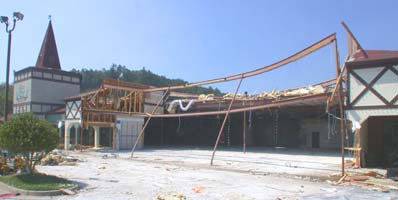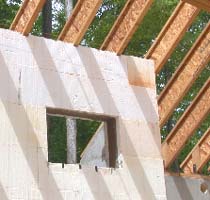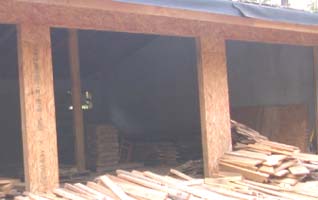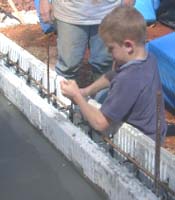Is this information useful for constructing homes in the mountains? Yes!
The southern Appalachian mountains are prone to tornadoes and other storms.
In the 1970's a severe tornado struck Murphy, North Carolina causing extensive destruction.
There have also been many smaller tornadoes since then,
such as the one that destroyed these buildings in Helen, Georgia:


There are many studies published on how we can build a stronger home without making it too expensive. In this article I will try to explain the basics in a way that is understandable even if you are not an expert. The key is to keep the wind outside of the house and keep the home from twisting apart under its force. If anything rips open and the wind gets inside, it can tear apart the entire home.
To understand how the wind affects a building imagine a giant balloon attached to a basket with lots of ropes. The balloon is like the roof. It takes only one weak spot for the wind to rip an opening in the surface, and the balloon to be torn apart. If the ropes are poorly anchored to the balloon, the wind could rip the balloon away from the basket. If one rope comes loose there will be more strain on the adjacent ropes, and they would begin to loosen. The ropes themselves could be weak and break when the wind blows on the balloon. Finally, if the ropes are not well anchored to the basket, the basket could separate from the balloon, with disatrous results for the occupants. This illustration will help us understand the important areas of a home's structure. Let's identify the key areas:
The roof keeps out the wind.
The roof is like the ballon surface. It cannot have a single weak spot that would rip open and allow the wind inside. Roof sheathing must be nailed according to the code and manufacturers' instructions. The gable end can also be a weak link in the roof. When building a home with roof trusses, many builders use a special gable truss at the end over the wall. This truss is very weak and difficult to tie to the rest of the framing. When this breaks, winds can enter the attic and rip the rest of the roof apart. Without spending any extra money, the builder could frame the entire gable wall in one piece, with each stud going from the floor all the way up to the roof surface. The wall could be lifted into place by the same crane that sets the roof trusses. Another way to eliminate gable end trusses is to build a hip roof instead of a gable roof. Engineers have found the hip roof to be much stronger for resisting wind.

The connection of the roof to the wall is the weakest link in most homes.
Just as the ropes must be well secured to the balloon to keep it from blowing away,
the roof must be securely attached to the walls.
The code requires that trusses be tied to the walls in a strong enough manner to stay attached even when the wind reaches the maximum speed for that area. Homes built on high epevation sites might have to be built for higher wind speeds.
If a storm tears this connection apart, your roof might become airborne.
This happens during many hurricanes and tornadoes.
To strengthen this connection, metal connectors (often called hurricane clips)
may be nailed to the truss and the wall.
Together these little plates have a lot of strength to hold the roof tight to the wall,
and they can cost less than $1 each.
I think that is a bargain!
The wall holds the home together.
There have been many errors in wall construction that left homes unprotected from the wind.
Just as a ballon needs strong ropes that are well anchored to the basket,
your home needs strong walls to hold everything together.
When the wind hits your home, tremendous forces try to twist the walls.
Even if the builder used good sheathing, the walls will come apart
if it was not attached with plenty of nails.
We have all seen old leaning barns.
They are leaning because they do not have enough diagonal bracing.
In the old days this was prevented by nailing boards at an angle
to keep the building from leaning with high winds.

With the invention of plywood and oriented strand board sheathing we have a much better way to brace a home.
These kinds of sheathing provide a lot more diagonal bracing than the old way.
You can increase the diagonal strength even more by using more nails.
This sheathing also prevents the wall framing from pulling apart.
Imagine the wind lifting the balloon, and stretching tight the ropes that carry the basket.
This same force could rip the studs apart from the other wood framing in the wall,
if they are not well tied together with lots of nails.
Be careful in selecting your sheathing because some of the new sheathing products
do not offer good storm protection.
Imagine the storm winds driving a piece of wood into your wall at high speed, like a giant bullet.
If your sheaqthing does not have good impact resistance, holes could be driven into your walls,
and the wind would get inside and begin tearing the house apart.
Sheathing made of foam or cardboard can be very weak.
The best sheathing would take a strong impact in a storm.
Be sure your home has good wall sheathing and it is nailed correctly.

Another mistake that makes a home weak is not having enough wall sheathing on each wall.
If because of garage doors or large window areas, a wall does not have enough sheathing area,
high winds could twist this wall and tear it apart.
Also many garage doors are not designed for high winds.
Because of these two reasons, many homes lose their garages in tornadoes and hurricanes.
Can you imagine the door giving way and the wind getting inside the garage and blowing out the weak ceiling?
In a short time the entire roof could be gone with the wind.
In areas prone to high winds, building departments require garage doors to be rated for higher winds.
The codes also allow for a super strong wall next to the garage door.
This design makes up for not having enough sheathing on that wall.
There are many other ways to strengthen a weak wall.
These are important points that should be considered when planning your home.
I have also seen another common error on the walls of homes that have more than one floor. The sheathing often has seams that line up with the joint between the wall and the floor. The home could easily blow apart in a storm, because there is nothing tying the upper level to the lower level. The upper level of the home could blow off and the occupants would not be in Kansas anymore! The sheathing panels must bridge across the floor, tying it to the studs in the wall above and below. This is why many knowledgeable builders make sure that the sheathing ties together all the framing from the foundation up to the roof. You can think of this as a chain. It is only as strong as the weakest link. If there is a weak link in your home, a storm can blow it apart at that point.
The foundation anchors the home to the ground.
Most people think of the foundation only as supporting the weight of the house. But it performs an even more critical function. It prevents your home from blowing away. (The wind would have to lift the weight of the concrete). The foundation works only if the house is anchored well to it. Anchor bolts are set in the concrete before it dries. They are threaded on the end so that the wood plate in the wall may be anchored to it with a nut and washer. Sometimes not enough anchor bolts are used. This would allow the entire house to blow off the foundation. This is especially common in older homes that were not anchored to the foundation. With all of the studies of home damage from the recent hurricanes, they have found this to be a weak area. Sometimes the wood plate can split apart around the anchor bolt. To prevent this, you may now use a larger stronger square washer. It is a cheap way to make your home much stronger.
Stronger building systems
While it is true that the craftsmanship in older homes was often superior, improvements have been made in some modern building systems that provide a stronger home. Some of these systems are well known for improving energy efficiency, but they also offer much more protection from storm damage.

ICF (insulated concrete forms) homes are among the strongest systems available.
All of the exterior walls are made of steel reinforced concrete inside foam insulation,
which is so much stronger than conventional construction.
They resist the twisting and uplift forces of high winds,
while offering tremendous protection from wind driven debris crashing into the walls.
SIPS (structural insulated panels) are also a very strong system. They are made of two panels of sheathing with foam insulation between. The double sheathing and the rigid foam work together to offer tremendous resistance to storm winds.
Another way to offer wind protection is by placing earth berms around the house. These banks of dirt would divert the wind away from the home, and brace the house against wind forces.
Would you like to see some of these ideas on a home being built? We are currently building a model home that demonstrates better building practices for the mountains. You can learn more about this project by clicking the drawing below. If you have any questions do not hesitate to contact me. If you are planning to build in the mountains, you may make an appointment to see this home under construction. We will also be having an open house right after our next Mountain Home Show.
I hope this information leads you to a better mountain home. If you have any questions, ideas, or would like more information, feel free to contact the author.
How to Contact Richard C. MacCrea
 My Facebook Page
My Facebook Page(Design news and ideas)
Email Me
(Opens an email window)
800.738.8781 P.O. Box 446, Murphy, North Carolina 28906
Other Pages on this Web Site
 The Mountain Home Show, Home Page and Site Map
The Mountain Home Show, Home Page and Site Map(How to find what you're looking for)
The Next Mountain Home Show Program
(For guests and exhibitors)
How to Get in The Mountain Home Show
(For exhibitors)
Articles
(About designing, building and remodeling a mountain home)
The Mountain Model Home
(A home that experiments with extreme energy efficiency)
The Mountain Model Cabin
(A cabin that experiments with small size and energy efficiency)
Construction Diary
(The joys and frustrations of building these two model homes)
Home Designing and Planning
(How to get plans for building or remodeling your home)
How to Contact The Mountain Home Show
Appreciation......
This web site contains information obtained from various sources.
The Mountain Home Show is not liable for the accuracy of this information.
Please contact the source of this information with your questions.
 Email Us
Email Us
(Opens an email window)
Like our Facebook Page
(Join our Mountain Home Show Community for news and contacts)
The Mountain Home Show, P.O. Box 446, Murphy, North Carolina 28906-0446
The Mountain Home Show owes its success to the businesses that participate in the show.
They arrange such wonderful exhibits.
It is obvious that they take great pride in their work and our show.
